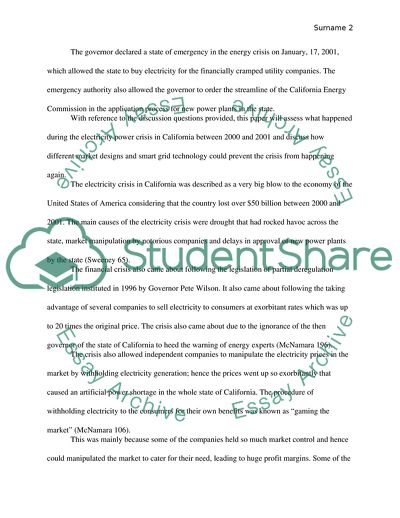Cite this document
(Californias Electricity Crisis During 2000 2001 Research Paper Example | Topics and Well Written Essays - 2500 words, n.d.)
Californias Electricity Crisis During 2000 2001 Research Paper Example | Topics and Well Written Essays - 2500 words. https://studentshare.org/engineering-and-construction/1772618-describe-what-happened-in-californias-electricity-crisis-during-2000-2001-and-discuss-how-different-market-designs-andor-smart-grid-technology-could-prevent-it
Californias Electricity Crisis During 2000 2001 Research Paper Example | Topics and Well Written Essays - 2500 words. https://studentshare.org/engineering-and-construction/1772618-describe-what-happened-in-californias-electricity-crisis-during-2000-2001-and-discuss-how-different-market-designs-andor-smart-grid-technology-could-prevent-it
(Californias Electricity Crisis During 2000 2001 Research Paper Example | Topics and Well Written Essays - 2500 Words)
Californias Electricity Crisis During 2000 2001 Research Paper Example | Topics and Well Written Essays - 2500 Words. https://studentshare.org/engineering-and-construction/1772618-describe-what-happened-in-californias-electricity-crisis-during-2000-2001-and-discuss-how-different-market-designs-andor-smart-grid-technology-could-prevent-it.
Californias Electricity Crisis During 2000 2001 Research Paper Example | Topics and Well Written Essays - 2500 Words. https://studentshare.org/engineering-and-construction/1772618-describe-what-happened-in-californias-electricity-crisis-during-2000-2001-and-discuss-how-different-market-designs-andor-smart-grid-technology-could-prevent-it.
“Californias Electricity Crisis During 2000 2001 Research Paper Example | Topics and Well Written Essays - 2500 Words”. https://studentshare.org/engineering-and-construction/1772618-describe-what-happened-in-californias-electricity-crisis-during-2000-2001-and-discuss-how-different-market-designs-andor-smart-grid-technology-could-prevent-it.


